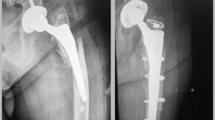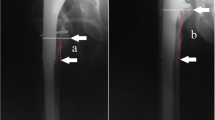Abstract
Introduction
Modular revision stems with a short distal component can prevent the bypassing of the femoral isthmus and hereby theoretically have advantages concerning risk of periprosthetic fractures, breakage of the junction and a technically easier revision procedure.
Materials and methods
Radiological evaluation of 202 stem revision operations with the modular curved revision stem “Revitan Curved” with a 2° taper was carried out after a mean follow-up period of 7.44 ± 2.09 years (3–13 years) to investigate whether short-stem combinations are effective in Paprosky 2 and 3A defects with respect to rate of subsidence and loosening.
Results
Sixty of 62 endofemoral (96.8%) and 137 of 140 transfemoral implantations (97.9%) involved the short, 140 mm distal component. Significant subsidence was seen in 3.3% of cases following endofemoral implantation and in 2.1% of cases following transfemoral implantation. Neither aseptic loosening nor periprosthetic fracture were observed.
Conclusion
The use of combinations of short modular components leads to reproducibly good outcomes in femoral revision with respect to subsidence and loosening.




Similar content being viewed by others
References
Böhm P, Bischel O (2004) The use of tapered stems for femoral revision surgery. Clin Orthop Relat Res 420:148–159
Artiaco S, Boggio F, Titolo P, Zoccola K, Bianchi R, Bellomo F (2011) Clinical experience in femoral revision with the modular Profemur R stem. Hip Int 21:39–42
Pattyn C, Mulliez A, Verdonk R, Audenaert E (2012) Revision hip arthroplasty using a cementless modular tapered stem. Int Orthop 36:35–41
Wirtz DC, Heller KD, Holzwarth U, Siebert C, Pitto RP, Zeiler G, Blencke BA, Forst R (2000) A modular femoral implant for uncemented stem revision in THR. Int Orthop 24:134–138
Fink B, Urbansky K, Schuster (2014) Mid term results with the curved modular tapered, fluted titanium Revitan stem in revision hip replacement. Bone Jt J 96-B(7):889–895
van Houwelingen AP, Duncan CP, Masri BA, Greidanus NV, Garbuz DS (2013) High survival of modular tapered stems for proximal femoral bone defects at 5 to 10 years follow-up. Clin Orthop Relat Res 471:454–462
Köster G, Wald TA, Willert HG (2008) Five- to 10-year results using a noncemented modular revision stem without bone grafting. J Arthroplasty 23:964–970
Kwong LM, Miller AJ, Lubinus P (2003) A modular distal fixation option for proximal bone loss in revision total hip arthroplasty. A 2- to 6-year follow-up study. J Arthroplasty 18:94–97
Fink B (2016) Letter to the Editor: Is there a benefit to modularity in “simpler” femoral revisions? Clin Orthop Relat Res 474:2538–2539
Fink B (2018) What can the surgeon do to reduce the risk of junction breakage of modular revison stems. Arthroplasty Today 4:306–309
Fink B, Hahn M, Fuerst M, Thybaut L, Delling G (2005) Principle of fixation of the cementless modular revision stem Revitan. Unfallchirurg 108:1029–1037
Fink B, Oremek D (2016) The transfemoral approach for removal of well-fixed femoral stems in two-stage septic hip revision. J Arthroplasty 31:1065–1071
Fink B, Grossman A, Schubring S, Schulz MS, Fuerst M (2008) Short-term results of hip revisions with a curved cementless modular stem in association with the surgical approach. Archiv Orthop Trauma Surg 129:65–73
Fink B, Grossmann A, Fuerst M (2010) Distal interlocking screws with a modular revision stem for revision total hip arthroplasty in severe bone defects. J Arthroplasty 2010;25:759–765
McInnis DP, Horne G, Dvane PA (2006) Femoral revision with a fluted, tapered, modular stem. Seventy patients followed for a mean of 3.9 years. J Arthroplasty 21:372–380
Fink B, Grossmann A (2007) Modified transfemoral approach to revision arthroplasty with uncemented modular revision stems. Oper Orthop Traumatol 19:32–55
Fink B, Grossmann A, Schubring S, Schulz MS, Fuerst M (2007) A modified transfemoral approach using modular cementless revision stems. Clin Orthop Relat Res 462:105–114
Nunn D, Freeman MAR, Hil PF, Evans SJW (1989) The measurement of migration of the acetabular component of hip prostheses. J Bone Jt Surg Br 71-B:629–631
Paprosky WG, Lawrence J, Cameron H (1990) Femoral defect classification. Clinical application. Orthop Rev 19(Suppl):9–15
Paprosky WG, Greidanus NV, Antoniou J (1999) Minimum 10-year results of extensively porous-coated stems in revision hip arthroplasty. Clin Orthop Relat Res 369:230–242
Challgahan JJ, Slavati EA, Pellicci PM, Wilson PD, Ranawat CS (1985) Results of revision for mechanical failure after cemented total hip replacement, 1979 to 1982. A two to five-year follow-up. J Bone Jt Surg 67-A:1074–1085
De Menezes DFA, Le Béguec P, Sieber H-P, Goldschild M (2012) Stem and osteotomy length are critical for success of the transfemoral approach and cementless stem revision. Clin Orthop Relat Res 470:883–888
Russell RD, Pierce W, Huo MH (2016) Tapered vs cylindrical stem fixation in a model of femoral bone deficiency in revision total hip arthroplasty. J Arthroplasty 31:1352–1355
Funding
There is no funding source.
Author information
Authors and Affiliations
Corresponding author
Ethics declarations
Conflict of interest
The authors declare that one of the authors is a consultant of ZimmerBiomet, but no author was supported for this paper.
Ethical approval
This article does not contain any studies with human participants or animals performed by any of the authors.
Informed consent
Informed consent was obtained from all individual participants included in the study.
Rights and permissions
About this article
Cite this article
Fink, B., Buntenbroich, U. & Oremek, D. Fixation of a modular curved revision stem with a taper of 2° in the femur. Arch Orthop Trauma Surg 139, 127–133 (2019). https://doi.org/10.1007/s00402-018-3067-x
Received:
Published:
Issue Date:
DOI: https://doi.org/10.1007/s00402-018-3067-x




